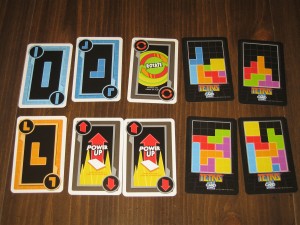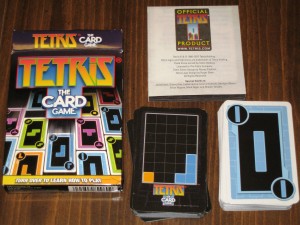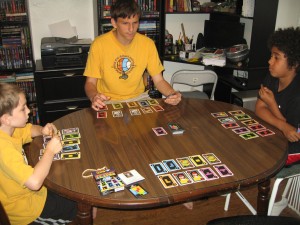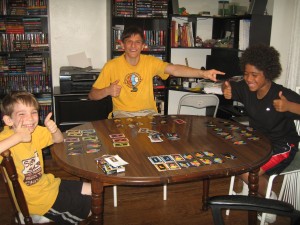Tetris Link, a board game that I recently reviewed, was well received in our household. When I discovered that there was a Tetris card game, however, I was on the fence. How can something like Tetris be adapted to cards? Yet, I couldn’t ignore that the board game adaptation was an overall success among the kids.
In Tetris: The Card Game, players will be attempting to be the first one to score a predetermined number of lines. Points can be lost as the game progresses, so it is important to continue to make as many lines as possible on your turn, if you can. Let’s take a quick moment to look at the components, setup, and gameplay before heading into the review.
Components
The only components that the box contains are two-sided cards and a manual. One side of the card is called the “matrix side”, which shows a picture of various Tetris blocks stacked in a particular way. The other side of the card is called the “tetrimino side”, which shows one Tetris block (called tetriminos).
Setup
The deck is shuffled (tetrimino side down) and ten cards are dealt in front of each player, tetrimino side up. These cards have (almost) no bearing on gameplay and only serve to keep track of how many lines a player has completed. This group of ten cards will become an individual player’s score area. Ideally, players will want two rows of five going across to best make use of the space. One card is dealt to each player to form their hand, the tetrimino side is kept secret. The deck is placed tetrimino side down in the middle of the table, with enough space to the side for a discard pile. The player on the dealer’s left goes first.
Gameplay
On a player’s turn, they will perform the following actions:
1) Draw one card, making their hand count equal to two cards.
2) The player will look at the matrix side of the top card showing on the deck pile. They then choose one of their two cards that would best fit inside that matrix.
3) The player places the card tetrimino side up in the discard pile, announcing how the card will be rotated to fit the matrix. If any lines are formed as a result, then that player flips over one or more of their score cards to their matrix side. The conversion is one row per score card…so if the player were to make two lines, they’d flip over two score cards to their matrix side.

This player currently has four lines scored. That can go up or down, depending on how the rest of the game plays out.
If the player cannot form a line with either card, they simply discard one and are penalized by flipping a score card back to the tetrimino side. The next player, going clockwise, repeats the process and play continues until one player flips over all ten of their score cards to the matrix side.
There are special cards that players will draw that will affect gameplay in various ways. The “power-up” card, for example, let’s a player swap their power up card for one card in any opponent’s score pile. Other cards, like the “Drop 2” and “Drop 4” cards, forces an opponent to flip score cards back to their tetrimino side.
The Review
The kids didn’t receive it well at first, mainly because of how limited players were in what cards they could play on their turn. It came down to being lucky and drawing a good card to match whatever the matrix was showing…which isn’t all that strategic. I adjusted the rules a bit, allowing all players to have three cards (plus the one they draw on their turn) giving them double the options for playing cards. To compensate for how quickly someone could go out, I increased the score required to win. Twelve score cards made for a quick five to ten minute game, whereas fifteen lengthened the game a little longer. The kids were much happier with my variant than with the original rules…as they had more ways to play their cards.
As long as potential players go into this game with the expectation that it is not as strategic as the video game or the board game Tetris Link, they’d probably enjoy themselves. For this reason, I think the game would be excellent for younger kids who aren’t all that into medium to high strategy games. The cards force players to visualize how the matrix would look after placing the piece…which keeps with the overall theme of Tetris. Visual acuity and imagination are always good things to encourage in growing children and this game is light enough to start kids off early.
The final verdict? It’s a light, mostly luck driven card game that might appeal to those who just want an excuse to socialize, or to younger kids. Those going into this game wanting a challenge will be disappointed, but with the right variants and house rules, it can be made to fit and work with almost any family.
Final Verdict: 6/10
—



